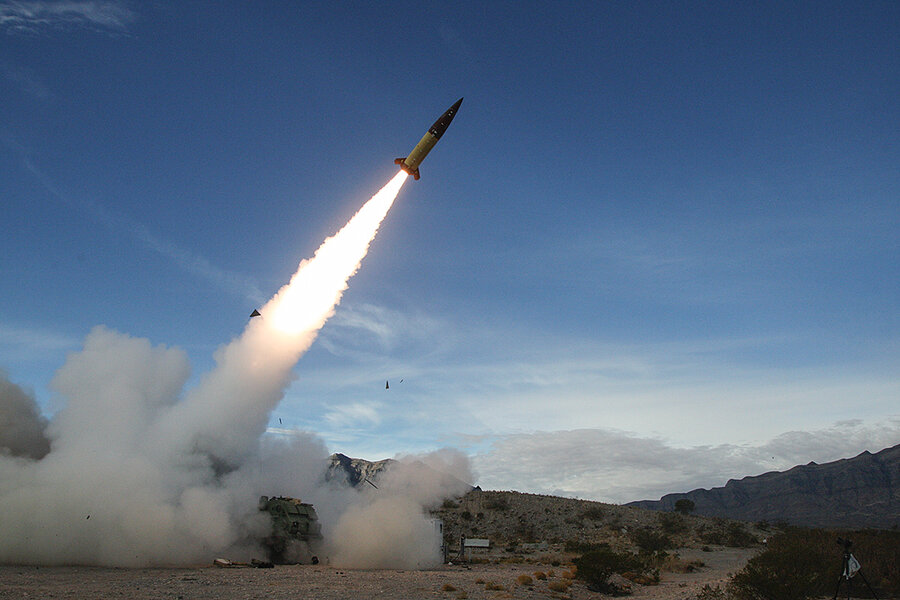Now tanks, next missiles? Expanding military aid buoys Ukraine.
Loading...
| RAMSTEIN AIR BASE, GERMANY
Ukraine’s fight to oust occupying Russian forces is being bolstered by a growing array of heavy American armaments – buoying fighters’ hopes even as analysts warn that weapons alone can’t guarantee victory.
U.S. Abrams tanks began arriving in Ukraine this week to help ground forces push into Russian-held territory. Next the Biden administration is reportedly poised to announce that U.S. long-range ballistic missiles, known as the Army Tactical Missile System, or ATACMS, will soon be on their way to the war zone, too.
Why We Wrote This
A story focused onNew forms of U.S.-provided firepower promise to enhance Ukraine’s capabilities. But the weapons will arrive amid tension between Ukrainian resolve and the human toll of a slow counteroffensive.
These weapons, their acronym fittingly pronounced “attack-em’s,” have been at the top of Ukraine’s wish list since the start of Russia’s February 2022 invasion. With a range of 190 miles, they can strike further into Russian-held territory than any other missile that nations have thus far provided to Kyiv.
Still, their expected arrival comes with no guarantee that Ukraine will be able to accelerate its progress against dug-in Russian lines as troops head into another winter of war.
The counteroffensive “is taking longer than the planners in the war games ... anticipated,” Mark Milley, chair of the Joint Chiefs of Staff, acknowledged last week. “But that’s the difference between war on paper and real war. There are real human beings, in real vehicles, moving across real minefields.”
Ukraine’s fight to oust occupying Russian forces is being bolstered by a growing array of heavy American armaments – buoying fighters’ hopes even as analysts warn that weapons alone can’t guarantee victory.
U.S. Abrams tanks began arriving in Ukraine this week, months ahead of initial estimates, to help ground forces push into Russian-held territory. Next the Biden administration is reportedly poised to announce that U.S. long-range ballistic missiles, known as the Army Tactical Missile System, or ATACMS, will soon be on their way to the war zone, too.
These weapons, their acronym fittingly pronounced “attack-em’s,” have been at the top of Ukraine’s wish list since the start of Russia’s February 2022 invasion. With a range of 190 miles, they can strike further into Russian-held territory than any other missile nations have thus far provided to Kyiv.
Why We Wrote This
A story focused onNew forms of U.S.-provided firepower promise to enhance Ukraine’s capabilities. But the weapons will arrive amid tension between Ukrainian resolve and the human toll of a slow counteroffensive.
They also mark the fulfillment of a mammoth list of heavy munitions for which Ukrainian President Volodymyr Zelenskyy has long lobbied. They have the potential to cause considerable disruption to Russia’s war effort, defense analysts say. Still, some add, their expected arrival comes with no guarantee that Ukraine will be able to accelerate its progress against dug-in Russian lines as troops head into another winter of war.
The counteroffensive “is taking longer than the planners in the war games … anticipated,” Gen. Mark Milley, chair of the Joint Chiefs of Staff, acknowledged last week, with the bluntness that has characterized his assessments of conditions there. “But that’s the difference between war on paper and real war. There are real human beings, in real vehicles, moving across real minefields.”
U.S. tanks and long-range missiles, in addition to being powerful tools of war, will be big morale boosts for Ukraine. But to ultimately attain what U.S. officials say is the desired end state – a “just and durable peace” – Kyiv and its allies must also be honest in the weeks to come about what these weapons can and cannot do, analysts say.
General Milley, for his part, has warned of the difficulty that Ukrainian fighters face going forward. Russia has built trenches fortified with “minefields, dragon’s teeth, barbed wire, strong points, and so on,” he said last week in Ramstein, Germany, following his final meeting of Western leaders supporting Ukraine before he retires at the end of this month.
While Ukrainian forces “have penetrated several layers of this defense,” he said, they are now “going very slow” as they endeavor to push through a “defensive belt that stretches the entire length and breadth of Russian-occupied Ukraine.”
The decision to give U.S. long-range missiles to Ukraine represents a striking evolution in thinking on the part of the Biden administration.
Evolving U.S. positions
In summer 2022, national security adviser Jake Sullivan downplayed the notion of providing them in order, he said, to avoid a “Third World War.”
Earlier this month, when asked about concerns that weapons like ATACMS could be used to strike beyond Russian-occupied Ukraine into actual Russian territory, U.S. Secretary of State Antony Blinken struck a philosophical note.
“When it comes to how Ukrainians use these systems, the targeting decisions are theirs – they’re not ours,” he said. “As a matter of our own policy, we do not encourage, nor do we enable, the use of our weapon systems outside of Ukraine – but again, fundamentally these are Ukrainian decisions.”
As wars progress, “parties to the conflict learn more about what does and does not count as escalatory,” says Anthony Pfaff, research professor in military strategy and ethics at the U.S. Army War College’s Strategic Studies Institute.
The shift of Western allies from earlier extreme caution toward potential Russian redlines could in turn represent “more tolerance for risking escalation up to a certain point,” he adds.
At the same time, “Ukraine is at war with Russia. An attack on a legitimate military target inside Russia is in line” with the parameters of international law, Dr. Pfaff notes.
As Ukraine continues to strike inside Russia, there could be a growing acceptance among Western backers that this is as it should be.
The United Kingdom and France have already supplied Ukraine with their own long-range missiles, with ranges of up to 155 miles.
“The lack of Russian response to these deliveries, even after they’ve reportedly been used quite effectively on the battlefield, indicates that ATACMS wouldn’t be a bridge too far,” says Benton Coblentz, a defense analyst at the Atlantic Council’s Eurasia Center.
The challenges for Ukraine
Still, there will be no easy answers for a Ukrainian victory in this war, Western military officials repeatedly emphasize.
It is true, for example, that ATACMS will be highly effective when they first arrive on the battlefield, says Daniel Davis, a retired Army lieutenant colonel and now a senior fellow at the Defense Priorities think tank in Washington.
That’s because the long-range missiles will “put an entire swath of territory in play that wasn’t before,” he notes.
Their warheads, considerably more powerful than those of their shorter-range counterparts, will also be capable of striking larger targets – causing great damage to Russian logistics networks, for one thing, Mr. Coblentz adds.
When High Mobility Artillery Rocket System (HIMARS) missile launchers were supplied to Kyiv last year, for example, Ukrainian troops used them to great effect, demolishing Russian ammunition and fuel depots, logistical bases, and command centers.
That may happen again with ATACMS, but not for very long, Mr. Davis predicts. After encountering HIMARS, Russian commanders learned to spread out, camouflage, or move forces out of range. They also deployed “pretty effective electronic warfare” to jam GPS signals and decrease weapons’ accuracy.
What’s more, there remains the crucial issue of troop strength for Ukraine in the face of tremendous losses of Ukrainian fighters. “It’s a finite number,” Mr. Davis adds, “and not expandable.”
There are some 200,000 to 300,000 Russians currently fighting in Ukraine. Even if Kyiv’s goals of ejecting them are realistic, Ukrainian leaders must also consider the costs of accomplishing this, analysts point out.
As Ukrainians are wounded and die in battle, it lessens Kyiv’s “future capacity, its capacity to function as a state – you’re just wiping out their potential for a generation,” Mr. Davis adds.
This is the historic tragedy of war; how to disrupt it is less clear.
Some argue that Kyiv, with momentum on its side and Western support at a zenith, needs to get to the negotiating table in the near future to freeze the lines and “make the best deal with Russia for Kyiv to maintain its political independence and all the territory it has right now,” as Mr. Davis puts it.
Decisions about when it’s time to consider a political settlement are ultimately Ukraine’s to make, military officials including General Milley have emphasized. President Zelenskyy has said that negotiations can’t begin until Russian soldiers are ejected from Ukrainian soil.
Until this happens, or his position changes, into the foreseeable future, Defense Secretary Lloyd Austin is urging fellow defense ministers to “dig deep,” dipping into their “formidable” arsenals to “continue to move heaven and earth to get Ukraine what it needs right now and over the long haul.”
As autumn turns to winter, the grounds will get muddy, then freeze again as the war continues. “There’s no intention whatsoever by the Ukrainians to stop fighting,” General Milley stressed in his valedictory address at Ramstein.
“And every inch of reclaimed territory” will be the result of “the bravery, the honor, and the incredible sacrifice” these soldiers will make as they face off against Russian forces mobilized by Vladimir Putin last year to man the “bleak and lonely” shadows of desolate trenches.
“They’re not extraordinarily well trained, not extraordinarily well led,” General Milley said, “but they are there.”









